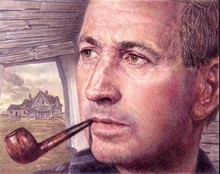Bernard Safran
| Bernard Safran | |
|---|---|

Self portrait, 1974
|
|
| Born | 1924 New York City, NY, United States |
| Died | October 14, 1995 Moncton, New Brunswick, Canada |
| Nationality | American |
| Occupation | Painter |
| Known for | Time magazine cover portraits |
Bernard Safran (1924 – October 14, 1995) was an American painter known for his highly realistic portraits and scenes of everyday life in New York and in Rural Canada. He created many portraits for covers for Time magazine, with subjects that included Elizabeth II, Pope John XXIII, Dwight D. Eisenhower, John F. Kennedy, Lyndon B. Johnson and Richard Nixon.
Bernard Safran was born in 1924 in New York City. His parents were emigrants from Russia. At an early age Safran showed artistic abilities. He studied at The High School of Music & Art in New York, and later at the Pratt Institute. During World War II (1939–45) Safran joined the United States Army Corps of Engineers and served in China, Burma and India.
After the war, in 1946 he start to work as a freelance book jacket illustrator for western and mystery novels. A sample title is Nightclub Sinner by Harry Whittington (New York, 1954).Wayward Girl, A Shocking Expose of Youth Gone Wild by Doug Duperroult (1954) is another example. He also illustrated magazine articles, such as Stand by for Danger in the April 1954 issue of Boys' Life, one of many stories he illustrated for that magazine. The work paid reasonably well, but he became dissatisfied with it and decided to become a serious artist. He spent six months in the mid-1950s studying and copying work at the Metropolitan Museum of Art by old masters such as Peter Paul Rubens, Diego Velázquez and Rembrandt.
Safran worked as an illustrator for Time from 1957 to 1966. Other illustrators of Time covers during this period, which has been called the golden age of Time covers, included Boris Artzybasheff, Robert Vickrey, James Ormsbee Chapin and Boris Chaliapin. Covers included works such as Kenya's Tom Mboya, in which Safran showed a dreamy-eyed Mboya dressed in coat and tie in front of a white settler on one side and a native African on the other, with Mount Kenya in the background. His illustration of President Eisenhower shows Eisenhower in front of a diagram depicting ties between Washington, London, Paris and Bonn, representing the military–industrial complex. He depicted Cuba's Che Guevara for the August 8, 1960 edition and [Pope] John XXIII for the January 4, 1963 edition.
...
Wikipedia
